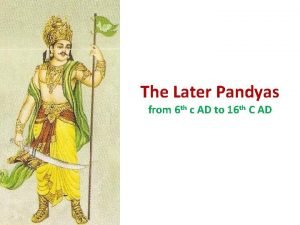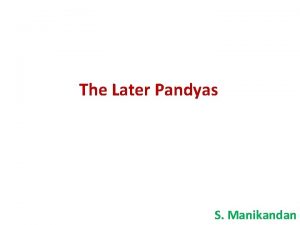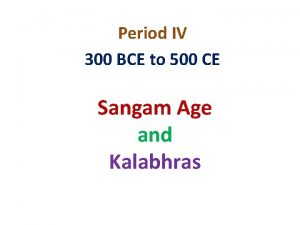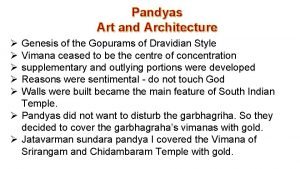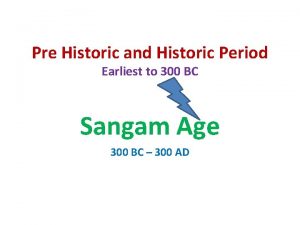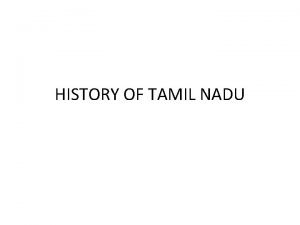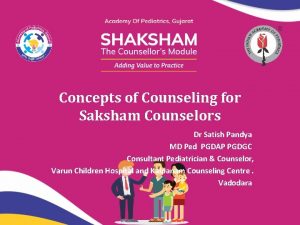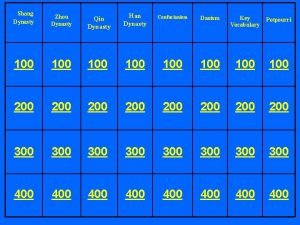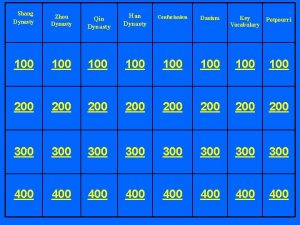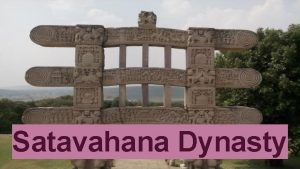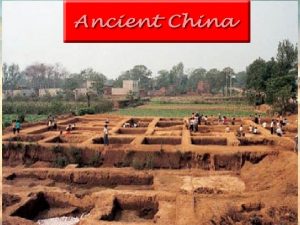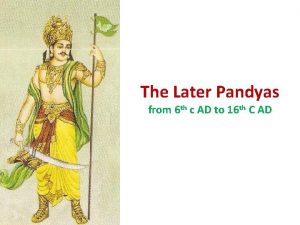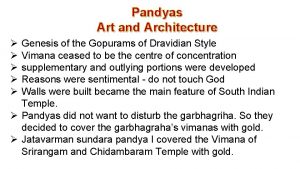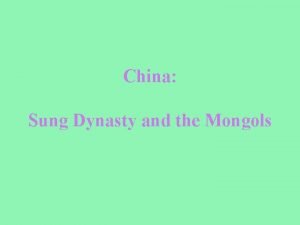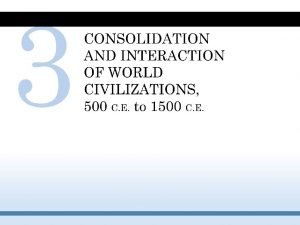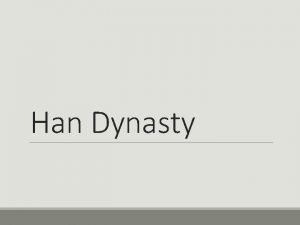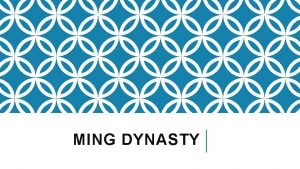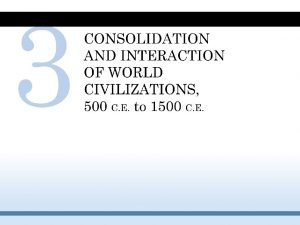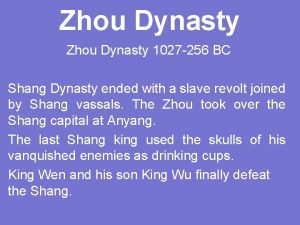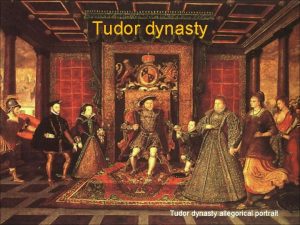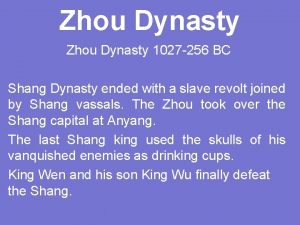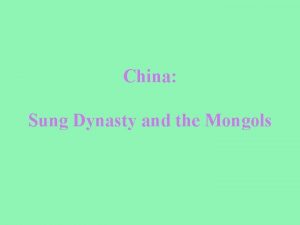The Later Pandyas S Manikandan Pandya Dynasty around




























- Slides: 28

The Later Pandyas S. Manikandan

Pandya Dynasty (around 300 B. C to 1378 AD) • They were the longest ruling dynasty of Indian history. They ruled the southern most part of India and their main capital was Korkai, from where they ruled their country Pandya Nadu. Korkai was a seaport situated on the southernmost tip of the Indian Peninsula. Later it was moved to Madurai. • First Indian Ambassador from Pandya Dynasty is sent to Rome. (26 BC). • The dynasty extended its power into Kerala (southwestern India) and Sri Lanka during the reigns of kings Kadungon (ruled 590 - 620 A. D), Arikesari Maravarman (670 -700 A. D), Varagunamaharaja I (765 -815 A. D), and Srimara Srivallabha (815862 A. D).

• It passed through two periods of imperial dominance, between the 6 th and 10 th centuries ce, and under the later Pandyas, beginning with Sundara Pandya I (r. 1216– 1238), when they controlled much of south India before succumbing to the onslaught of the Delhi Sultanate from 1311. • Pandya influence peaked in Jatavarman Sundara Pandya's reign 1251 -1268 A. D. After forces from the Delhi sultanate invaded Madurai in 1311, the Pandyas declined into merely local rulers. • Its weakness was partly brought about by a civil war over the succession between the sons of Kulesakaran and partly by inadequate military technology. • It was an important center of Tamil culture and (especially Hindu temple) architecture, which developed greatly during the periods of imperial dominance, assisted by the wealth that came with conquest as well as the long-established maritime trade and the exploitation of the coastal pearl banks. Religion and state involvement in it were an important buttress to the Pandyan dynasty.

• Jatavarman or Maravarman Pandyan was generally the names of the Pandyan Kings. • Earlier they were believed to be Jains but after a few centuries of rule they became Shaivaits. • Cheras were the allies of Pandyas for a long time as compared to the Cholas. • Only due to their dependence with Cholas and Cheras they could continue free movement and carry out trade along the coast of Sri Lanka.


• The Pandya Empire was a dynasty, which finds its place in Sangam literature, and later sources show their rule till 15 th century AD. The territory was also known as Pandya Country. • The Pandya kings adopted the fish or a pair of Fishes as their family crest.

Origin of the Pandyas • It is believed that the Dravidians must have penetrated into the southern part of the country in about 700 BC and organized developed themselves into distinguishable sects. • The existence of such a community can be justified with titles such as Cholas, Pandyas, and Cheras. Initially in the first century AD, the Pandya Kingdom consisted of only the greater part of modern Madurai and the district of Tirunelveli. • It was in the beginning of the thirteenth century AD that the famous Marco Polo tagged this dynasty as the richest existing empire. • During the Pandyan Empire a great development in the architecture was seen with the construction and inauguration of many temples, some of which are Meenakshi Amman Temple in Madurai and Nellaiappar Temple, located on the bank of the river Tamirabarani in Tirunelveli.

Extent of Pandya Empire: • The Pandya country, as per the traditions extended from the Pudukottai district in north to Kanyakumari in south covering Achankovil River in Kerala and River Vaigai (Madurai. • The kingdom was ordinarily divided into 5 principalities which were known as “Five Pandyas“.

The Capital of Pandyas • Korkai, which is now an insignificant village in Tamil Nadu, was the commercial capital and important port of the Pandya Kingdom. • Korkai has been a cradle of South Indian Civilization and as per traditions; it is considered the home of three brothers who were supposed to have founded the Pandya, Chera and Chola Kingdoms. • Korkai was center of Pearl trade and this trade was the chief source of wealth for the Pandya Kings. • Today, Korkai is located 6 kilometers from the coast. The shift is because of the silting up of the delta, which rendered Korkai inaccessible to ships. After Korkai, the commercial capital of the Pandyas was shifted to a new port of at a town Old Kayal, which were about one and half kilometers from the mouth of river Tamiraparani of Tirunelveli district.

Madurai, the Later Capital of Pandyas • Madura, the later capital of Pandyas was the central seat of Tamil Sangam literature. • Today, Madurai is one of the oldest continuously inhabited cities. Madurai was located on the banks of River Vaigai in Tamil Nadu. • In Sangam literature, Madurai finds special place in Mathuraikkanci, a Pathinenmaelkanakku anthology. This work praises a Pandya King Nedunchezhiyan. Similarly Madurai has been described by Pliny, Ptolemy and Strabo too.

Pandya kings were • • • Koon Pandiyan Mudukudumi Paruvaludhi Nedunj Cheliyan I (Aariyap Padai Kadantha Nedunj Cheliyan) Nedunj Cheliyan II Kadalan valuthi Nan Maran Kadalul Maintha Ukkirap Peruvaludi Nedunj Cheliyan III (Talaiyaalanganathu Seruvendra Nedunj Cheliyan) Maran Valudi Musiri Mutriya Cheliyan Pudappandiyan The Pandyans influences were seen at the highest point during the reigns of Jatavarman Sundara's, 1251 -68.

Visit of Marcopolo • Marcopolo, a Venetian traveller landed in Pandya Empire (at Kayal) in 13 th century and impressed by the wealth and magnificence of the King, Prince as well as people, tagged it as the richest kingdom in existence. • However, the same silting process in 14 th century caused the abandonment of the Kayal too, and the Portuguese were compelled later to shift their business to a port of Tuticorin, which was free from silting of Delta.

Political History of Pandyas • No continuous history of the Pandya Kings prior to 12 th century AD has been clearly written. • In Maurya Period, the Pandya Kingdom was independent. One of the Pandya Kings had sent an embassy to Augustus Caesar. Pandya Kingdom was well known to Greeks and Romans for its pearl trade. • Many Roman coins have been found on many places in Pandya Empire, which shows an existence of a well-developed trade between the Romans and Pandyas in the early centuries AD.

First Pandya Empire • Post Sangam period, the first Pandyan empire was established by a King named Kadungon, who defeated Kalabras in 6 th century AD. • The successors of Kadungon indulged in fighting with the nearby Chera and Chola Kings. • Huen Tsang, who visited in 6 th century AD traveled up to Kanchi which was southernmost point of his itinerary. He has mentioned the people of this area as Malakottai may refer to the Pandyan kingdom. • Huen Tsang mentions that the people in this region little cared for learning; there were Buddhist Monasteries, which were almost in ruins.

• The last Pandya King of this first Pandyan Empire was Maravarman Rajasimha II who ruled from 900 -920 AD. He was a contemporary of the Chola King Parantaka Chola I, who overran his kingdom and captured Madura. Parantaka Chola-I after this victory, earned the title of Maduraikondan. • Rajsimha II fled to Ceylon after this defeat and returned to Kerala, where he lived in low profile under a Chera King. • The great Rajaraja Chola-I in 1000 AD, reduced the Pandya Empire, akin to the other kingdoms of South, to a tributary and after that, it continued for a century or even long under the Cholas. • In the turn of the 13 th century, a vassal of Chola Empire named Jatavarman Kulasekaran I ascended to the Madura Throne in 1290, turned rebel to Cholas. The Cholas invaded him and sacked Madurai. • Jatavarman Kulasekaran I surrendered to the Chola king Kulothunga with wife and son and acknowledging his surrender, he was returned his capital. But during this, the ancient coronation hall of Pandyas in Madurai was destroyed and it also destroyed the records if any of the previous Pandyas. This was the reason that the history of Pandyas lost in obscurity.

Sundara Pandyan • To take revenge of this assault, younger brother of Kulasekaran, named Maravarman Sundara Pandyan, who came into power in 1216 AD, invaded the Chola Kingdom. • The armies of Sundara Pandyan sacked the cities of Thanjaur and Uraiyur of Chola Kings and drove the Chola kings out in exile. His armies marched up to Chidambaram and in memory of this victory, Sundar Pandyan conducted a Thulabaram at the Chidambaram temple and donated wealth equal to his weight. • But, victory of Sundar Pandyan over Cholas was followed by a march of the Hoyasala army towards Sri Rangapattam. Kingdom of the Cholas was returned after interference of Hoysala king Vira Ballala III, but now Cholas accepted suzerainty of the Sundara Pandyan. This was the revival of second Pandyan Empire.

Jatavarman Sundara Pandyan • After Maravarman Sundara Pandyan, we know about his successor Jatavarman Sundara Pandyan (1251 -61). • He was a mighty conqueror who invaded Ceylon and carried off the great booty. The famous tooth relic of Buddha was also included in this booty. • With this victory Jatavarman Sundara Pandyan was called “Second Rama” for plundering the Island of Sri Lanka. He adorned the Srirangam temple with Gold. He also conflicted with the Kakatiya Kings of Warangal.

The last days… • Kulashekhara Pandya I, towards the end of his life began to favour Vira Pandya, his “illegitimate” son born of a courtesan/mistress over his “legitimate” son, Sundara Pandya. • Upon Kulashekhara Pandya’s death in 1308, a civil war broke out between the brothers paving way for decline of the kingdom.

Fall of the Pandyas • At first , during the time of the invasion of the Kalabhras, the Pandyas, as of the Sangam literature marched into complete obscurity. • It was in about 940 AD, that the Chola king Rajaraja reduced the Pandyas to tributary dependence which lasted for about the following two centuries.

Cont… • It was in 1311 that Madurai was invaded by the Delhi Sultanate forces that the conditions of the Pandyas worsen and they turned into mere local rulers. • The Pandyan Kingdom was succeeded by other powers, such as Madura Sultans, Vijayanagara Rayas, Nayakas of Madurai, Nawabs of Arcot. • Towards the end of the sixteenth century, the Pandya dynasty suddenly disappeared from Indian historical scene forever.

Decline and end of the Pandyas • The Pandya Empire is among the most famous dynasties to have ruled Tamil Nadu and finds a place of pride with the Cholas, Cheras, and Pallavas. • Among other things, the Pandyas were renowned to be great patrons of pretty much all aspects of Sanatana Dharma— dance, art, temple-building, sculpture, music, and literature. • A tribute of sorts to the greatness of the Pandya empire is given by Muthuswami Dikshitar, singer, composer, ragafounder, and one of the Carnatic Classical Trinity along with Thyagaraja and Shyama Sastri. • In his Meenakshi Memudam Dehi set in Raga Poorvi Kalyani, he describes the Goddess of Madurai, Meenakshi as Malayadhwaja Pandya Raja Tanaye—daughter of the Pandya King.

Invasion of Malik Kafur and Muhammad Bin Tughlaq • Early in the 14 th century, a dispute arose about the succession of the Pandya throne and one of the claimants appealed to the Sultan of Delhi, Alauddin Khilji for help. This probably resulted in an invasion by the Sultan’s forces in 1310 under Malik Kafur. • Malik Kafur sacked, looted Madura and marched up to Rameshwaram, where he erected a mosque. After that invasion, the Pandya kings ruled sporadically at undefined territories and a sort of confusion was there. • Malik Kafur was followed by another expedition from the Delhi Sultanate by Muhammad Bin Tughlaq created a southern province and placed Sayyid Jalal-ud-Din Ahsan as its governor. • In 1333 AD Sayyid declared his independence and created Madurai Sultanate was replaced by the Nayak governors, who kept on ruling until arrival of British.

Malik Kafur Returns • When the Pandya brothers united at once, They knew Kafur’s force was far superior to their own but put up a courageous fight. • They never gave him a direct, open fight. They knew the country intimately and put this knowledge to the best use. • They attacked his force stealthily and displayed superior guerrilla warfare taking care never once to fall into his hands. • For weeks without end, they harassed Kafur. And then the rains came to hamper Kafur even further.

Assessment of the Madurai Sultanate • It is ridiculous to describe a short-lived and highly-unstable Muhammadan rule in Madurai as a Sultanate. Even at the height of their power, their rule didn’t cover the entire Pandya country whereas Vira Ballala III still held sway over major parts of Tamil Nadu from Thiruvannamalai in the north to Kannanur-Koppam in the south (where he met his end thanks to his own folly). • The other parts of South India witnessed the unstoppable march of the Sangama brothers. At various points, the Madurai “Sultanate” had captured a few important ports on the South-eastern coast, and had friendly relations with the Muhammadan king of Maldives. • Apart from this, there’s nothing in the history of this rule that qualifies it for the title of a Sultanate. They didn’t conquer new territory, didn’t win back Tughluq’s lost Ma’bar territory, effected no lasting reforms, were cultureilliterates, and were not known for effective and stable governance. • If anything, the Madurai “Sultanate” is simply a record of ceaseless palace intrigue, murder for power, plunder, succession battles, fight for survival, and eventual annihilation.

• The Madura “Sultanate” that lasted for 43 years between 1335 -78 was essentially a swift succession of nine murderous plunderers who styled themselves as Sultans. • Harihara and Bukkaraya learnt precisely these lessons at the feet of Vidyaranya. If we trace the history of the Vijayanagar Empire, the founders spent the better part of their lives subduing stubborn and egoistic Hindu chieftains, and trying to convince other rulers of the urgent need to unite under a single, strong umbrella to face, and defend themselves against the barbaric onslaught of Islamic imperialism. It is the lesson North India forgot several centuries ago and paid a heavy price.

The Campaign of Kumara Kampana • Meanwhile, important developments had taken place elsewhere in South India. The five Sangama brothers had begun a slow takeover of weakening and weakened but important empires in the south. The eldest brother, Harihara I appointed his brother, Bukkaraya or Bukka I as the ruler of Gutti, a village in today’s Belgaum district. • Bukka I had a fierce and able warrior in his son, Kumara Kampana’s greatest accomplishment lies in bringing the entire Tamil country under the Sangama brothers, which was later to become known as the Vijayanagar Empire. A chief ingredient in this accomplishment was the decimation of the Madurai Sultanate.

• Perhaps the best surviving account of Kumara Kampana’s campaign deep into the Tamil country comes from his own wife, Ganga Devi. A woman of many talents, and an accomplished poetess, she composed an exquisite Sanskrit epic-heroic poem entitled Madhuravijayam (Conquest of Madura), also known as Kamparaya Charitam. • All Sanskrit scholars and literary critics unanimously agree that Madhuravijayam is one of the greatest accomplishments in Sanskrit poetry—besides its theme—in terms of elegance, form, linguistic excellence and other literary parameters. • However, the value of Madhuravijayam as a first-person, contemporary historical record is inestimable. Thus, at this point, it is important to take a deeper look at the context of Madhuravijayam.

Madhuravijayam • Madhuravijayam narrates the actual reason Kampana launched the campaign to end the Sultanate at Madurai: a lady, a citizen of Madura meets Kampana with an urgent grievance. • She appeals to Kampana to save the Tamil country from the horrific tyranny of the Turushkas (derived from “Turks, ” denoting Muhammadans). • She implores the king of the urgent need to save the Tamil country—urgent, because any delay would completely extinguish whatever is worth saving. • The lady’s heart-wrenching entreaty forms the transition from the 7 th canto to the 8 th in the epic poem.
 Later pandyas
Later pandyas Pandya dynasty capital
Pandya dynasty capital Chola chera pandya
Chola chera pandya Pandyas art and architecture
Pandyas art and architecture Ezhisai vallavan
Ezhisai vallavan Senguttuvan chera
Senguttuvan chera What goes around comes around example
What goes around comes around example Goes around comes around meaning
Goes around comes around meaning Neela pandya
Neela pandya Dr satish pandya
Dr satish pandya Dr bharat pandya
Dr bharat pandya Cách giải mật thư tọa độ
Cách giải mật thư tọa độ Chụp phim tư thế worms-breton
Chụp phim tư thế worms-breton Tư thế ngồi viết
Tư thế ngồi viết ưu thế lai là gì
ưu thế lai là gì Thẻ vin
Thẻ vin Cái miệng nó xinh thế
Cái miệng nó xinh thế Thơ thất ngôn tứ tuyệt đường luật
Thơ thất ngôn tứ tuyệt đường luật Các châu lục và đại dương trên thế giới
Các châu lục và đại dương trên thế giới Từ ngữ thể hiện lòng nhân hậu
Từ ngữ thể hiện lòng nhân hậu Diễn thế sinh thái là
Diễn thế sinh thái là Slidetodoc
Slidetodoc Thế nào là giọng cùng tên
Thế nào là giọng cùng tên Phép trừ bù
Phép trừ bù Chúa yêu trần thế
Chúa yêu trần thế Khi nào hổ mẹ dạy hổ con săn mồi
Khi nào hổ mẹ dạy hổ con săn mồi đại từ thay thế
đại từ thay thế Vẽ hình chiếu vuông góc của vật thể sau
Vẽ hình chiếu vuông góc của vật thể sau Quá trình desamine hóa có thể tạo ra
Quá trình desamine hóa có thể tạo ra
